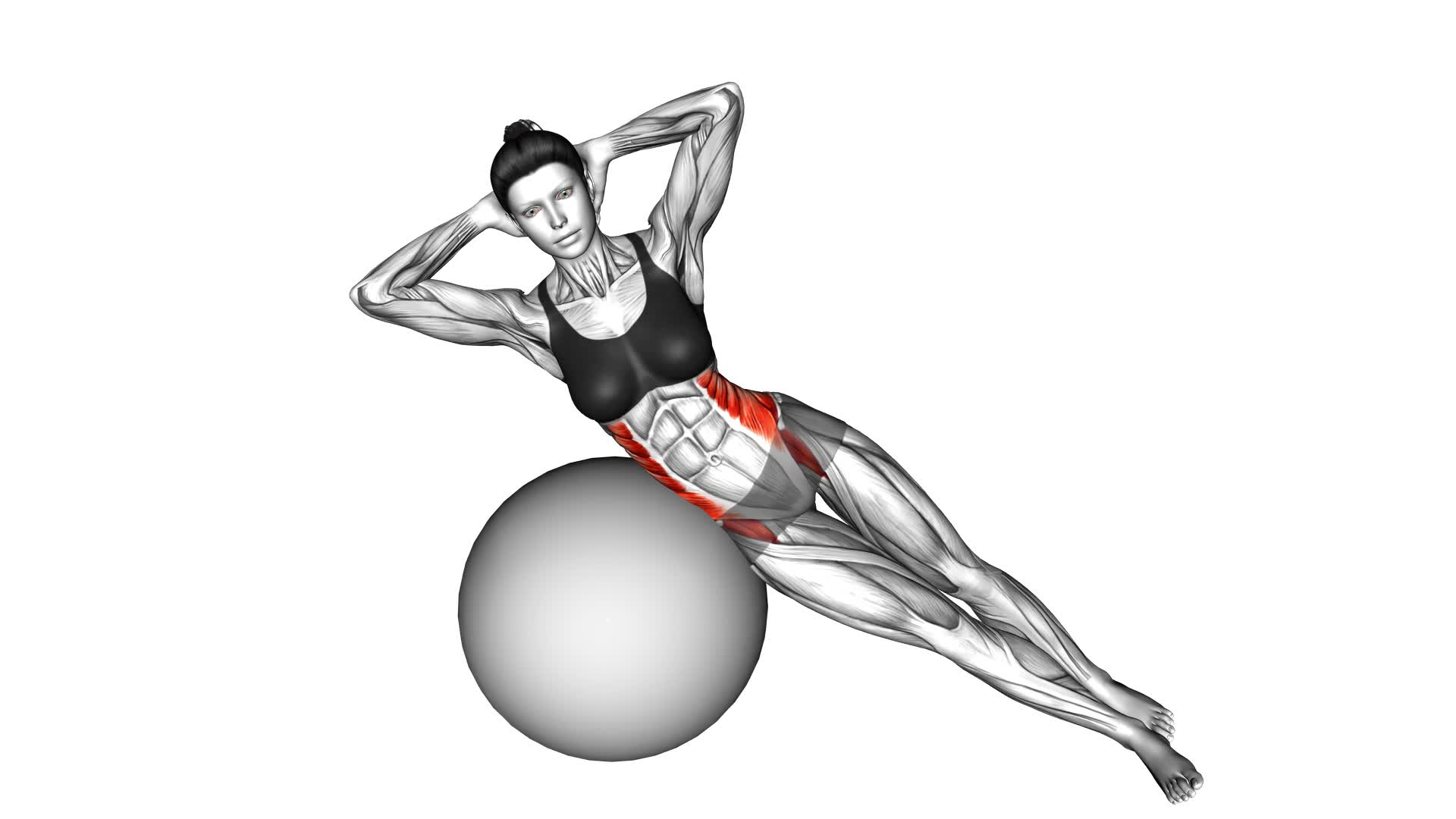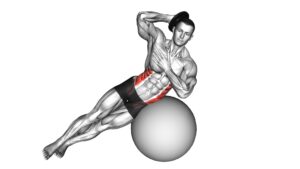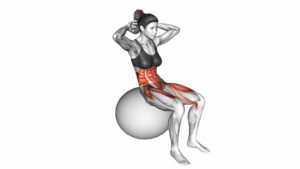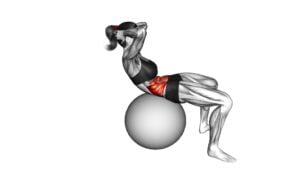Side Bend (On Stability Ball) – Video Exercise Guide & Tips

Get ready to strengthen and tone your core with the Side Bend on Stability Ball.
Watch This Exercise Video
This video exercise guide will show you the proper technique and provide helpful tips to maximize your workout.
Using a stability ball adds an extra challenge to this exercise, engaging your stabilizing muscles for a more effective workout.
Whether you're a beginner or advanced, this guide will help you master the Side Bend and take your fitness to the next level.
Key Takeaways
- Side Bend on Stability Ball targets the obliques for improved core stability and strength.
- It engages stabilizing muscles for a more effective workout.
- The exercise increases muscle activation and strengthens the core, as well as works other muscles like quadratus lumborum and erector spinae.
- There are various variations of the exercise that can target different areas of the obliques.
Benefits of Side Bend on Stability Ball
Experience the numerous benefits of incorporating Side Bend on a Stability Ball into your workout routine. This exercise targets your obliques, the muscles on the sides of your abdomen, helping to improve core stability and strength. By performing the Side Bend on a Stability Ball, you can enhance the effectiveness of this exercise and take your fitness to the next level.
The Stability Ball provides an unstable surface, which challenges your core muscles even more. This instability forces your obliques to work harder to maintain your balance, resulting in increased muscle activation and a stronger core. Additionally, the Side Bend on a Stability Ball engages other muscles, such as the quadratus lumborum and erector spinae, which help stabilize and support your spine.
There are various variations of the Side Bend on a Stability Ball that you can incorporate into your routine to keep challenging your muscles and prevent plateaus. You can use dumbbells or resistance bands to add extra resistance, or you can perform the exercise with your feet elevated to further engage your core. Experimenting with different variations will help you target different areas of your obliques and keep your workouts interesting.
Incorporating Side Bend on a Stability Ball into your routine offers numerous benefits, including improved core strength, enhanced muscle activation, and increased stability. With the variety of variations available, you can customize your workout to suit your fitness level and goals. So, try adding Side Bend on a Stability Ball to your routine and see the amazing results for yourself.
Equipment and Setup for Side Bend Exercise
To properly set up for the Side Bend exercise on a stability ball, begin by positioning the ball against a wall or another stable surface.
Make sure the ball is inflated to the appropriate level to provide stability and support.
Take necessary safety precautions, such as ensuring the area around the ball is clear of any obstacles or hazards, to prevent accidents or injury during the exercise.
Proper Ball Positioning
Place the stability ball between your feet and against the wall to ensure proper positioning for the side bend exercise. This ball stability is crucial for maintaining balance and stability throughout the exercise.
By positioning the ball in this way, you create a stable base of support, which allows you to engage your core effectively. The core engagement is essential for maintaining proper form and maximizing the benefits of the side bend exercise.
When the ball is positioned correctly, make sure that your feet are hip-width apart, and your knees are slightly bent. This stance will provide stability while allowing for a full range of motion during the exercise.
Remember to keep your torso straight and your shoulders relaxed to avoid unnecessary strain.
Safety Precautions for Stability
To ensure your safety during the side bend exercise on the stability ball, it's important to take certain precautions with the equipment and setup. By following these safety measures, you can prevent injuries and maintain stability throughout the exercise.
Firstly, make sure your stability ball is properly inflated and in good condition. Check for any signs of wear or punctures that could compromise its stability. Additionally, place the ball on a non-slip surface to prevent it from moving during the exercise.
Next, position yourself on the ball with your feet shoulder-width apart for a stable base. Keep your core engaged and maintain a neutral spine throughout the movement. This will help you maintain balance and stability.
Lastly, start the side bend exercise with light weights or no weights at all. Focus on proper form and gradually increase the resistance as you become more comfortable and confident with the exercise.
Proper Technique for Side Bend on Stability Ball
Engage your core and maintain stability as you perform the Side Bend exercise on a stability ball. The Side Bend is a great exercise for targeting your obliques and improving core strength.
To properly execute the Side Bend on a stability ball, start by sitting on the ball with your feet planted firmly on the ground. Place your hands behind your head, elbows out to the sides. Slowly lean to one side, keeping your abs engaged and your back straight. Be sure to maintain control throughout the movement and avoid jerking or bouncing. Return to the starting position and repeat on the other side.
To add variation to your side bend workout, you can try using dumbbells or a resistance band. Hold the weight or band in one hand while performing the side bend, adding resistance and challenging your muscles even more.
Incorporating the side bend into a full body workout can be beneficial. It helps to improve your balance and stability while targeting your obliques. You can include the side bend in a circuit training routine or as part of a core workout.
Remember to always warm up before performing any exercises and consult a fitness professional if you have any concerns or questions about your form.
Common Mistakes to Avoid During Side Bend Exercise
To perform a side bend exercise with proper form, it's important to avoid excessive twisting. When demonstrating the exercise, make sure your movements are controlled and focused on the lateral flexion of the spine.
Proper Form Demonstration
Avoid leaning too far to the side during the Side Bend exercise on the stability ball. To demonstrate proper form, start by sitting on the stability ball with your feet shoulder-width apart and firmly planted on the ground. Place your hands behind your head or hold a weight at your side.
Engage your core muscles and maintain a straight posture throughout the exercise. Slowly lean to one side, keeping your upper body aligned and avoiding any excessive sideways movement. Return to the starting position and repeat on the other side.
Remember to exhale as you bend to the side and inhale as you return to the starting position. By maintaining proper form, you can effectively target your obliques and improve your stability.
Avoiding Excessive Twisting
To prevent excessive twisting during the Side Bend exercise on the stability ball, make sure you keep your upper body aligned and avoid any excessive sideways movement. Maintaining proper form is crucial to avoid strain or injury.
Here are some important tips to help you avoid excessive twisting and maintain core stability:
- Engage your core muscles throughout the exercise to provide stability and support.
- Keep your shoulders square and facing forward, avoiding any rotation or twisting.
- Focus on the lateral movement of your spine, rather than twisting your torso.
- Use controlled and deliberate movements, avoiding any jerking or sudden motions.
- Start with lighter weights or resistance and gradually increase as your core strength improves.
Modifications and Progressions for Side Bend on Stability Ball
Try these variations to challenge yourself and progress your side bend on the stability ball.
To modify the exercise and make it more accessible, you can start by using a smaller stability ball or placing the ball against a wall for added support. This will help you maintain balance and stability as you perform the side bend movement.
To progress the exercise and make it more challenging, you can try performing the side bend with weights. Hold a dumbbell or kettlebell in one hand while you perform the exercise, focusing on maintaining proper form and control throughout the movement. This will increase the resistance and intensity of the exercise, targeting your oblique muscles even more.
Another progression you can try is performing the side bend on an unstable surface, such as a BOSU ball or a foam mat. This will require more core stability and balance, as the unstable surface will challenge your muscles to work harder to maintain control.
Remember to always start with proper form and technique before attempting any modifications or progressions. Listen to your body and only progress when you feel comfortable and confident in your abilities.
Incorporating these modifications and progressions into your side bend routine will help you continue to challenge and strengthen your core muscles.
Tips for Getting the Most Out of Side Bend Workout
To maximize the benefits of your side bend workout, focus on maintaining proper form and engaging your core muscles throughout the exercise. By following these tips, you can ensure that you're maximizing your results and improving stability:
- Keep your feet hip-width apart and firmly planted on the ground to provide a stable base of support.
- Keep your spine elongated and your shoulders relaxed to maintain proper alignment and prevent strain.
- Engage your core muscles by drawing your navel towards your spine and contracting your abdominal muscles.
- Slowly and controlledly lower your body to the side, avoiding any jerky or sudden movements.
- Exhale as you lower your body to the side and inhale as you return to the starting position.
By incorporating these tips into your side bend workout, you can enhance your overall stability and maximize the effectiveness of the exercise.
Remember to start with a weight that challenges you but allows you to maintain proper form, and gradually increase the difficulty as you become stronger. Keep in mind that consistency is key, so aim to perform this exercise regularly to see the best results.
Frequently Asked Questions
What Is the Recommended Number of Repetitions for the Side Bend Exercise on a Stability Ball?
The recommended number of repetitions for the side bend exercise on a stability ball is determined by your fitness level and goals.
Side bends are great for targeting and strengthening your oblique muscles.
By engaging your core and stabilizing on the ball, you can improve your posture, balance, and overall stability.
It's important to start with a comfortable number of repetitions and gradually increase as you become stronger and more comfortable with the exercise.
Can Side Bend on a Stability Ball Help With Improving Posture?
Side bend on a stability ball has several benefits for improving posture. By targeting the muscles in your core, back, and obliques, this exercise helps to strengthen and stabilize your spine.
It also promotes proper alignment and balance, which can contribute to better posture overall. Additionally, variations of the side bend can be done to target different muscle groups or increase the intensity of the exercise.
Incorporating this exercise into your routine can be a valuable tool for improving your posture.
Is It Necessary to Use a Stability Ball for the Side Bend Exercise, or Can It Be Done Without One?
To perform the side bend exercise, you may wonder if it's necessary to use a stability ball. While using a stability ball offers benefits, such as increased core activation and improved balance, there are alternatives to consider.
These alternatives include using a yoga block, a dumbbell, or even just your body weight. However, using a stability ball can provide an additional challenge and engage more muscle groups.
Ultimately, the choice depends on your preferences and goals.
What Muscles Does the Side Bend on a Stability Ball Primarily Target?
The side bend on a stability ball primarily targets the oblique muscles, which are located on the sides of your abdomen.
By performing this exercise on a stability ball, you engage your core muscles even more, as they work to stabilize your body. This increases the intensity of the exercise and helps to improve your balance and stability.
The side bend on a stability ball also helps to improve your posture and strengthen your lower back muscles.
Can the Side Bend Exercise on a Stability Ball Be Modified for Individuals With Lower Back Pain or Injuries?
If you're dealing with lower back pain or injuries, there are modified variations of the side bend exercise on a stability ball that you can try. These modifications can help alleviate strain on your lower back while still targeting your core muscles.
The side bend exercise, when done correctly, offers several benefits such as improved core strength, increased flexibility, and improved posture.
It's important to consult with a fitness professional or physical therapist to ensure you're performing the exercise safely and effectively.
Conclusion
In conclusion, the side bend exercise on a stability ball is a great way to strengthen and tone your core muscles, particularly your obliques.
By maintaining proper technique and avoiding common mistakes, you can maximize the effectiveness of this exercise.
Remember to start with the appropriate equipment and make modifications or progressions as needed.
With these tips, you can get the most out of your side bend workout and achieve your fitness goals.

Author
Years ago, the spark of my life’s passion ignited in my mind the moment I stepped into the local gym for the first time. The inaugural bead of perspiration, the initial endeavor, the very first surge of endorphins, and a sense of pride that washed over me post-workout marked the beginning of my deep-seated interest in strength sports, fitness, and sports nutrition. This very curiosity blossomed rapidly into a profound fascination, propelling me to earn a Master’s degree in Physical Education from the Academy of Physical Education in Krakow, followed by a Sports Manager diploma from the Jagiellonian University. My journey of growth led me to gain more specialized qualifications, such as being a certified personal trainer with a focus on sports dietetics, a lifeguard, and an instructor for wellness and corrective gymnastics. Theoretical knowledge paired seamlessly with practical experience, reinforcing my belief that the transformation of individuals under my guidance was also a reflection of my personal growth. This belief holds true even today. Each day, I strive to push the boundaries and explore new realms. These realms gently elevate me to greater heights. The unique combination of passion for my field and the continuous quest for growth fuels my drive to break new ground.







